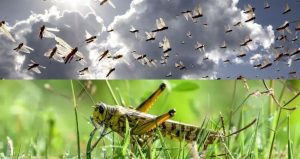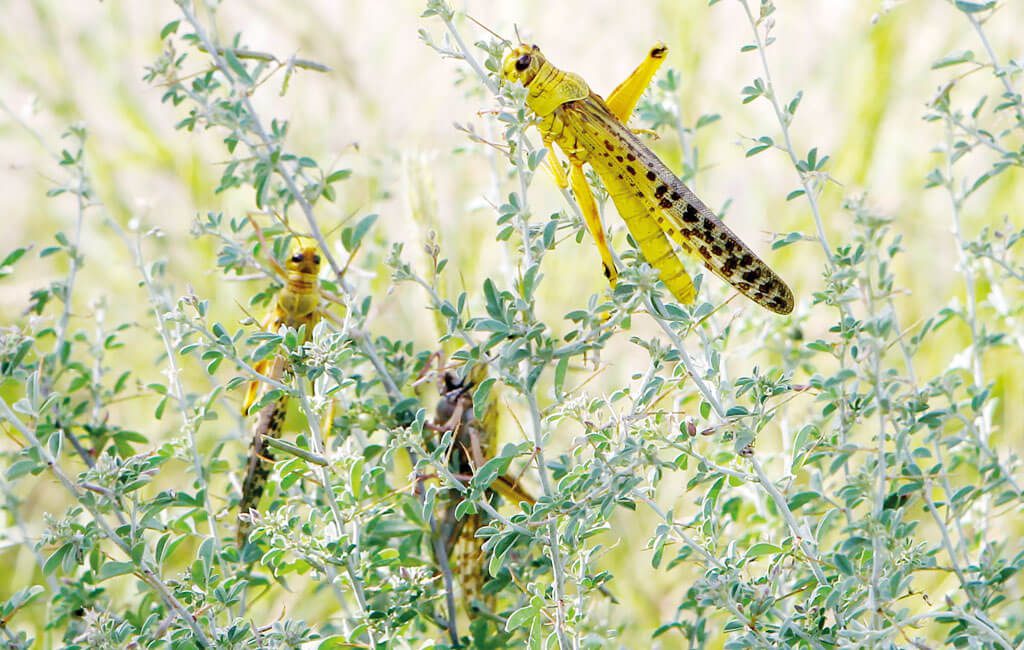Reading Time: 5 minutes
Tabassum analyses the possibility of locust attack in Bangladesh, after the attacks in Pakistan and India. An exclusive for Different Truths.
 “And at last the locusts did descend. They settled on every tree and every blade of grass; they settled on the roofs and covered the bare ground. Mighty tree branches broke away under them, and the whole country became the brown-earth colour of the vast, hungry swarm.”
“And at last the locusts did descend. They settled on every tree and every blade of grass; they settled on the roofs and covered the bare ground. Mighty tree branches broke away under them, and the whole country became the brown-earth colour of the vast, hungry swarm.”
~ Things Fall Apart, Chinua Achebe
Coronavirus, economic crisis, cyclone and now the threat of the locust attack. The subcontinent is indeed going through the worst crisis after World War II. Locust swarm attack was seen in East Africa, in December 2019. They have reached Pakistan and India. What is the locust? Why they are attacking? What are the reasons behind the attack? Locust is an insect which is quite similar to grasshopper and cricket. All these three insects belong to the same family. Locusts are generally found in desert regions and the unique thing about this is that as compared to grasshoppers and crickets, it exists in two forms meaning it has two phases. These forms are when it is present alone, then it is called a solitary phase. But when it is present in crowds and the environmental conditions are congenial like wet soil after recent rainfall with trees and plants in full bloom, they transform their forms completely. This phase is called the gregarious phase.
Coronavirus, economic crisis, cyclone and now the threat of the locust attack. The subcontinent is indeed going through the worst crisis after World War II. Locust swarm attack was seen in East Africa, in December 2019. They have reached Pakistan and India.
This metamorphosis of the form changes everything about them, their behaviour, habits, appearance. Everything is different in the solitary phase and the gregarious phase. A problem arises when they exist in crowds and are in their gregarious phase. They are yellow and black. Their eating habit changes in the gregarious form. They can eat more food and more varieties of food. Their endurance increases and their movements become more rapid. Even their brain size becomes larger. What’s interesting is that they can transform into the gregarious phase from the solitary phase anytime. At any point in time in their lives as long as environmental conditions are for it is congenial. The apt environmental conditions are — recent rains, moist soil, and lush vegetation around. The swarms of these locusts are created in their gregarious phase. And these swarms destroy everything in their way. Because their eating habits change so much that they can eat almost everything. Leaves, shoots, flowers, fruits, seeds, stems, barks. They can eat almost all types of crops or non-crops be it paddy, wheat, grass, fruit trees or date palms. This is why destruction follows wherever they go.
How large can one locust swarm be? The swarm found in Kenya, in 2020, was 40 km by 60 km in dimension. The swarm can be as large as a rectangle of 40 km by 60 km. As in a swarm, there can be more than 150 million locusts within one square kilometre. A swarm can eat as much as 2500 people in a day. So, you can imagine the extent of its scale and how much destruction it can cause. And, this is why it is said that the locusts are a kind of species that have the most economic impact on the entire planet as compared to any other animal species.
How large can one locust swarm be? The swarm found in Kenya, in 2020, was 40 km by 60 km in dimension. The swarm can be as large as a rectangle of 40 km by 60 km. As in a swarm, there can be more than 150 million locusts within one square kilometre. A swarm can eat as much as 2500 people in a day. So, you can imagine the extent of its scale and how much destruction it can cause.
In India and Pakistan, they are found in large numbers because of the large extent of the desert areas in this region and these are the areas in which they cause the most destruction. India is a neighbouring country of Bangladesh. In 2020, India has faced the worst locust attack in 27 years. But this is not a recent phenomenon.

These locust attacks have been happening for thousands of years throughout human history. Even ancient Egyptians had drawn locusts on their tombs which tells us that there had been locusts attack even in that age. These tombs are dated around 2400 BC. So, this is a problem that has been festering for ages. But climate change is indirectly held responsible for the locust attacks happening today.
The sequence of events of how it happened is very interesting. The Indian Ocean is warming up more than usual due to climate change. The rains have become more extreme due to the enhanced heating of the ocean. Torrential rains hit east Africa around the time of December 2019. There were floods as well. East Africa includes Kenya, Uganda, Ethiopia, Somalia. These countries were badly flooded during December 2019. Due to the floods and the torrential rains, congenial environmental conditions are created for the locusts. The soil becomes moist and there is abundant vegetation around due to the rains. This becomes a great opportunity for the locusts to breed and change into the gregarious phase. So, the locusts began to breed in huge numbers there and a locust plague hit east Africa.
Around February 2020, there was a huge locust plague in Africa. After which, these swarms of locusts began to travel east. It travelled to Iran, then Pakistan and now by the time of May-June in India. The winds of Cyclone Amphan that had hit West Bengal and Bangladesh moved in such a direction and in such a way that these were further pushing the swarm of the locust towards India. They would not have normally travelled this way but they further moved in this direction because of the cyclone winds.
Around February 2020, there was a huge locust plague in Africa. After which, these swarms of locusts began to travel east. It travelled to Iran, then Pakistan and now by the time of May-June in India. The winds of Cyclone Amphan that had hit West Bengal and Bangladesh moved in such a direction and in such a way that these were further pushing the swarm of the locust towards India. They would not have normally travelled this way but they further moved in this direction because of the cyclone winds. And this is exerting a very negative influence on Madhya Pradesh, Uttar Pradesh, Rajasthan, Delhi and Haryana.
Under the circumstance, should Bangladesh be worried? According to the Daily Star, Bangladesh report (April 18, 2020), a swarm of insects were seen in Cox Bazar’s Teknaf Upazila, which raised concerns over locust attack amid the outbreak of coronavirus. Now, the recent attack in India was certainly panicky news. After investigation, experts said the insects were spotted grasshoppers. It’s a huge relief that the insects, which were seen in Teknaf are not destructive at all and farmers have nothing to fear. It only eats leaves of wild plants and does not attack any other common vegetative species. These insects were identified as Aularches Miliaris, belonging to the family of Pyrgomorphidae, a kind of grasshopper. Senior Locust Forecasting Officer Keith Cressman, United Nation’s Food and Agriculture Organization (FAO) confirmed that it was not the deadly desert locust (Schistocerca Gregaria) found in Cox Bazar’s Teknaf Upazila.
Keith feels that this deadly insect won’t come to Bangladesh and gave three main reasons — Bangladesh is too far from where the locust swarms are now; they don’t travel against the wind and most importantly the habitat and topography. Bangladesh is too wet and green and this environment is not favourable for the desert locusts at all to start living. Then again, climate change is making predictions harder.
Finally, everyone should have a good understanding of nature. Our indifference and ignorance did let loose one monstrous virus, Covid-19. Let’s not make things more complicated.
Photo from the Internet














